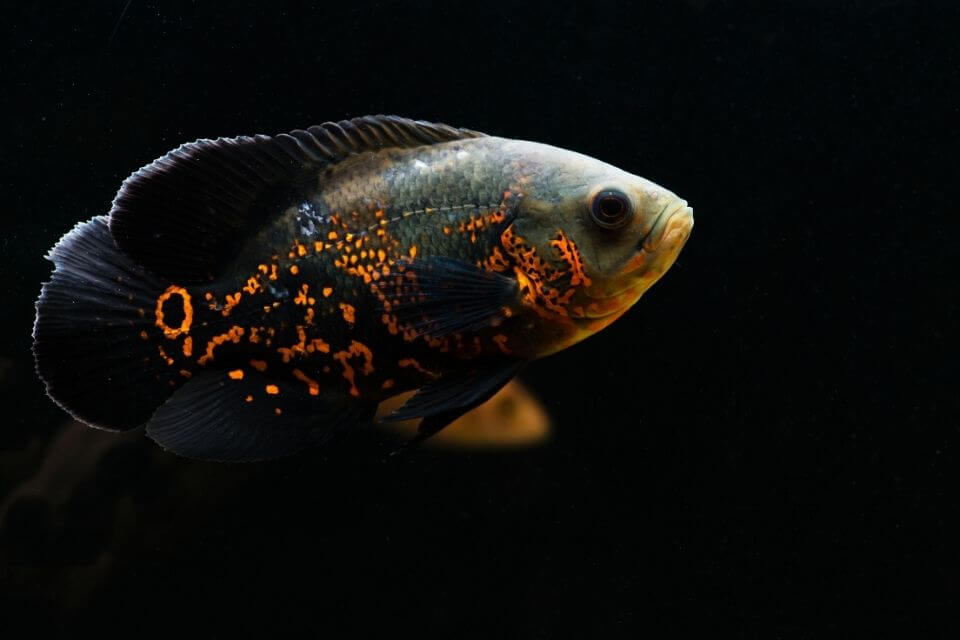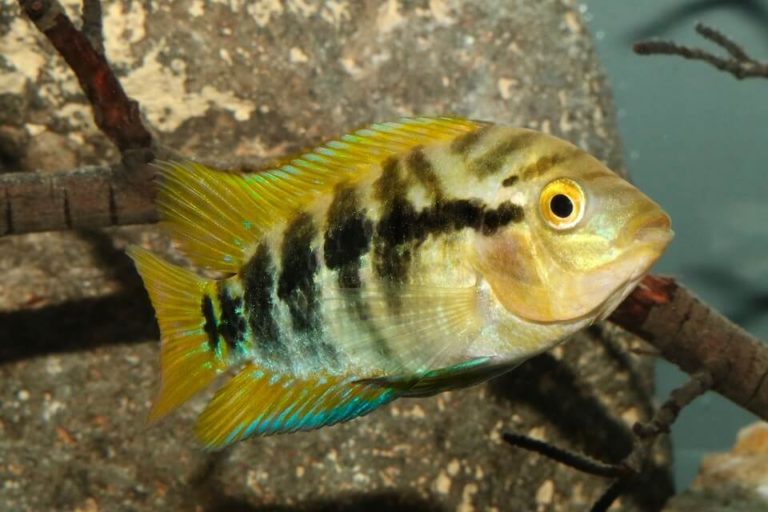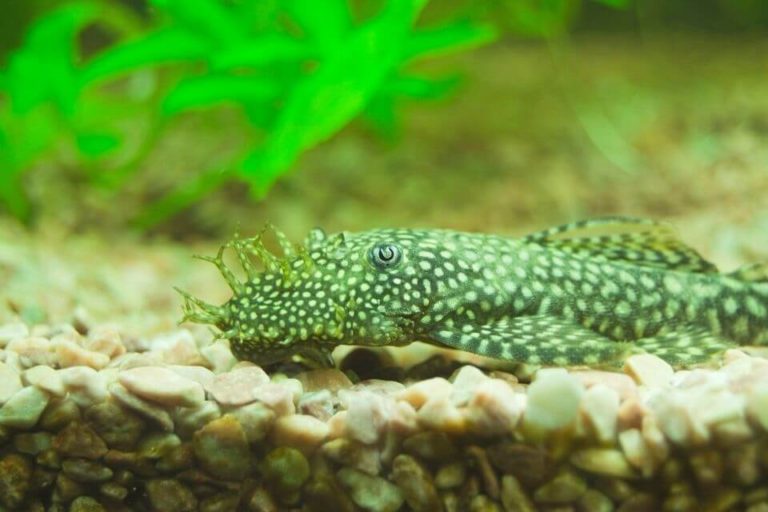Oscar Fish Care and Species Profile: Size, Lifespan, Tank Mates and More

Oscar Fish is one of the most famous Cichlid species that you can keep in a freshwater fish tank. It is an interesting fish, and you will love observing the fish as it grows.
For fish enthusiasts, you can easily study the patterns, behaviors, and characteristics of these fish species. The Oscar Fish is a semi-aggressive Cichlid species that are not suitable for keeping with most of the fish species.
In this article, you will get to know and understand the Tiger Oscar fish better, and it can guide you on the way forward on how to give good care to these freshwater species.
| Quick Facts: | |
|---|---|
| Common Names | : Tiger Oscar, Velvet Cichlids, Marble Cichlid |
| Scientific Name | : Astronotus ocellatus |
| Family | : Cichlidae |
| Origin | : Amazon and Orinoco River basins in South America |
| Care Level | : Medium |
| Lifespan | : Up to 20 years |
| Size (average) | : 12 inches |
| Diet | : Omnivorous |
| Breeding | : Egglayer |
| Social | : Territorial |
| Temperament | : Aggressive |
| Minimum Tank Size | : 50 gallons |
| Temperature | : 74 – 81 °F (23 – 27 °C) |
| Water Hardness | : 5 - 20 dGH |
| Water pH Level | : 6 - 8 |
Oscar Fish Overview
These fish species also known as the Velvet Cichlids or Marble Cichlid and sometimes referred to as “Tiger Oscar Cichlid“, are commonly reared at home as an aquarium pet.
This fish species belongs to the Cichlidae family and is scientifically known as Astronotus ocellatus.
This fish is mostly found in tropical water bodies in the South American region. The fish prefer slow-moving warm waters, and you can also find them in pods and flooded waters.
To rear these fish, you do not need any special equipment like most other freshwater fish species.
However, you need to keep the water temperature of your aquarium between 75 to 80 degrees Fahrenheit (23 to 27 degrees Celcius) since the Tiger Oscar fish come from tropical climates.
You also need to ensure you have enough space since the Tiger Oscar Cichlid can grow up to 12 inches long. A minimum of 50 gallons tank would be the ideal size for them to thrive well.
Oscar Fish Lifespan
If the Oscar fish are properly taken care of they have a long lifespan. They can live up to 15 years. To ensure Tiger Oscar fish lifespan for long, you only need to ensure they are well-fed.
Make sure it has good living conditions and prevents the chances of occurrence of diseases.
Appearance and Colors
Identifying different types of Oscar fish is not difficult since they vary in appearance and color patterns. In recent years there has been an increase in different types of Oscar fish as a result of interbreeding.
The Tiger Oscar Fish, Albino Oscar Fish, Red Oscar Fish, Lemon Oscar Fish, and Black Oscar Fish are the main types of Oscar fish. Oscar Fish has skin resembling that of a tiger.
You will notice these patterns near the tail but in some Oscar Fish. But on some Oscar fish, it covers the entire body. These color patterns and markings will start to appear when their maturity age.
Different Types Of Oscar Fish
As mentioned earlier you can spot these variations only of their color patterns and special marking while the size and lifespan remain the same for all Oscar fish types.
Tiger Oscar Fish
This is the most common type of Oscar fish and is a beautiful fish and can be easily identified by having a mix of two colors. The orange color with the back in a sporadic pattern spread out their entire body.
Albino Oscar Fish (Whie Tiger Oscar)
Because of the color pattern of Albino Oscar fish, it will stand out in your tank. The unique appearance of Albino Oscar fish makes them more demanding fish Oscal fish species in the aquarium trade.
The Albino Oscar is different from the other making them a unique appearance on each fish. Their body resembled orange color sports on the white-colored body.
Red Oscar Fish
It is beautiful fish with very bright colors. The patterns of the Red Tiger Oscars are orange and bright reddish. The other part of the body is mainly black and they have a dark band towards the end of their bodies.
The Red Oscar is easily identified as having two different colors. The colors are a mix of black and fiery red. Heir fins are black and their eyes have an orange rim that bulges above the head.
Lemon Oscar Fish
Lemon Oscar fish is one of the rare types that have a lemon-colored body covered with an orange color pattern. It is si pretty much similar to the Red Oscar fish appearance but in yellow color patterns. Every other characteristic remains the same.
Black Oscar Fish
Black Oscar fish is a beautiful fish with its whole body covered with black color. You will notice that their body had light colors bands running from head to tail.
It is noticeable that their eyes have an orange color rim and when you first see them you will note the body looks like a tiger

Oscar Fish Size
They are generally large fish and that is why you are advised to get large tanks if you are thinking of getting a Tiger Oscar. The purchase size of these fish is 2 to 3 inches.
They look small when being bought and they grow very fast over time. They can grow up to an average of 12 inches, but on some rare occasions up to 15 inches when providing optimal tank conditions.
These fish species have a growth rate of one inch every month for the first 6 months. After the first 6 months, the growth starts to slow down.
When providing optimal aquarium conditions and good feeding, the Oscar fish can get to 10 inches long within the first year.
Oscar Fish Care and Habitat Setup
When setting up a tank for your fish, you need to ensure that they will have good tank conditions and the environment will be conducive. Recreating an environment that resembles their natural habitat is important.
You need to ensure that the water is in your tank clean and healthy at all times by having an efficient filtration system that will clean the water regularly.
When setting up the tank, you also need to ensure that the tank has a weighted lid since these fish species are high jumpers.
– Oscar Fish Tank Size
Tiger Oscar tank size is also an important consideration when rearing them. People who keep their Oscars in smaller tanks will limit their growth and lifespan.
Some fish will have deformities, curved backs, and stunt bodies as a result of limited space. For a full-grown Tiger Oscar, you can use a tank that is longer and wider.
The minimum Tiger Oscar tank size should be 50 gallons or more. In 75 gallons tank, you can rear more than one Oscars ideally up to 2 fish.
If you are focused on only having one Oscar, 50 gallons will be sufficient. The general rule of thumb is 25 gallons per one Tiger Oscar Fish.
– Oscar Fish Tank Setup
Tiger Oscar tank setup will play an important role in fish growth and development. These fish are known to produce a significant amount of waste that may result in rising levels of ammonia and nitrate.
Therefore, you need to have a good filtration system that will help regulate the pH levels. Most Oscar enthusiasts recommend Canister filters
The natural lighting environment for this fish tends to be dim. Therefore, they do not really need aquarium lighting to thrive. But if you have live plants in the aquarium, you will require some light to ensure their growth.
You need to be very careful when installing the lights to avoid any instance of the lights getting destroyed by the Oscars. When setting up the tank, you can add debris, rocks, and decorations to your tank.
These additions will improve the living conditions of your fish. You should also ensure you have soft substrate at the bottom of the tank, this is because the Tiger Oscars enjoy digging.
You also need to add logs, bogwood, and caves in the tank. These additions help recreate the natural habitat for your Tiger Oscar fish. Also, make sure they will have ample space and different swimming spaces making their environment less stressful.
– Suitable Plants
When choosing the types of plants for the aquarium setting, you should keep in mind that the Tiger Oscars will easily uproot plants. Therefore, you need to get hardy plants. Floating plants like the Hornwort and Water Wisteria are also a good choice.
Instead of introducing living aquarium plants, you can your artificial plastic plants with a steady base. They cannot easily uproot them when they show off their aggressive behavior.
IMPORTANT: Using live plants in your aquarium is optional, and you can use artificial plastic plants. But unlike plastic plants, live plants maintain the water freshness by adding oxygen, utilizing nitrates, and removing carbon dioxide from the water. Hence the live aquarium plants are recommended.
– Water Parameters
These fish species originated from tropical climates so they are used to warm environments. So, you need to keep the water in your aquarium warm.
The water should be ranging between 74 to 81 °F (23 to 27 degrees Celcius). For better survival, you also need to ensure the pH levels are between 6 to 8 and 5 to 20 dKH of water hardness.
To maintain the water warmth you can install an aquarium heater in the tank that will regulate the water temperatures.
- Temperature: 75 – 80 °F (23 to 27 °C)
- Water pH: 6 to 8
- Hardness: 5 to 20 dKH
Oscar Fish Food and Feeding
They are omnivores, and they feed on almost anything. So, finding suitable Tiger Oscar fish food is not that difficult. While in their natural habitats, they eat fish, plant debris, small fish, larvae, and crustaceans.
In an aquarium, you can feed them on flake/ pellet foods. These foods contain all the nutrients the fish will need. You can even get the flake and pellets designed purposely for the Tiger Oscar Cichlids or other cichlids.
You can also feed them on live/ frozen foods. These foods should be full of proteins they include; bloodworms, brine shrimp, and daphnia.
The live foods re-introduce the Tiger Oscars to their natural habitats since they bring out their natural hunting instincts.
You can also chop some green vegetables for them or use them to make homemade fish foods. The best diet for them is a mixture of different types of foods because you will have a wide range of nutrients; hence, keeping your fish healthy.
Feed the fish a couple of times a day in food amounts that they can finish. As you feed them, you will see their aggression as they get excited around the food.
Oscar Fish Temperament and Behavior
They spend most of their time swimming in the mid-level of the tanks. When they get hungry, they swim down to the substrate to look for food.
When searching for food, you will see them uprooting plants and decorations in your tanks. The Tiger Oscar fish are also very territorial and aggressive, so they will not hesitate to attack other fish in your tank.
Tiger Oscar Fish Gender Differences
They are monomorphic fish; this means that the male and female look the same. It is, therefore, very difficult to differentiate the two by simply looking at them. Differentiating Tiger Oscar’s genders requires time and skill.
You cannot differentiate the genders of these fish species when they are very young. You have to wait until they are at least a year old to tell their genders. After a year, the Oscars are 4 to 5 inches long, and inspecting their genitals will be easier.
The male and female Tiger Oscars have different genitals; you need to closely observe the anal area to get a clear view of the different genitals. They both have two holes. One hole in the anus the other one is the reproductive organ.
You can also use the venting process to determine the difference between the male and female Tiger Oscars. To do this, you need to capture the fish in a net; while still in the water, closely observe the two holes and see which is male and female.
For males, the sexual organ forms a spike, while in females, the reproductive organ is wider and blunter. This is because it is the tube in which the eggs are released. The female hole is also bigger than the male hole.
The color of the skin around the two reproductive holes will vary slightly. The female skin will be lighter than the male’s skin.
Tiger Oscars Breeding
When you are a first-timer in rearing Tiger Oscars, you need to watch them diligently as they grow to identify when they start to mate. When they are ready to reproduce and mate, the female swims in circles with its belly almost touching the surface where they lay their eggs.
The female Tiger Oscar lay their eggs on a flat rock or any other surface of the tank.
The female also cleans the surface of the rock with her mouth in preparation for breeding. On the other hand, the male Tiger Oscar will follow the female Tiger Oscar, closely depositing milt (semen) over the eggs.
The female Tiger Oscar will lay its eggs even when there are no male Tiger Oscars in the tank. The Oscar fry hatches within 72 hours of being fertilized. Most of the time, the Tiger Oscars will eat their eggs.
If you want to increase the chances of the Tiger Oscars hatching, you should move the parents to a different tank.
Tiger Oscar Tank Mates
When the fish grow, they tend to be quite large, so you need to be careful when you choose Tiger Oscar tank mates. Also, you need to carefully choose the tank mates since these fish are aggressive and territorial.
When choosing Tiger Oscar tank mates, first, you need to buy fish that are not too small and peaceful. Do not buy any smaller fish than 5 inches; otherwise, it will fit in their mouth.
Also, go for fish that can compete for food in the tank. If you buy a timid fish, there is a high probability that it will not have enough food. Also, timid and shy fish will be chased away by the Tiger Oscars.
For a timid fish species, the environment with a Tiger Oscar could be very stressful. You can choose fish that dwell at the bottom.
This way, you will leave your fish all the space they need since the Tiger Oscars dwell better in mid-level areas.
Some of the Tiger Oscar tank mates include:
- Jack Dempsey Fish
- Blue Acara
- Firemouth Cichlids
- Black Convict Cichlids
- Chocolate Cichlids
- Green Terrors
- Silver Dollar Fish
- Arowanas
However, it would be best if you avoided larger cichlids like the Texas cichlid because they are aggressive, causing problems in the tank and making the environment stressful for other fish.
Oscar Fish Common Diseases
Just like any other living thing, the Tiger Oscars are prone to diseases. Five common diseases strike the Oscars, including a hole in the head disease, ich, tail and fin rot, Popeye disease, and bloat. These diseases are easy to recognize.
By observing your fish, you can easily tell when they are not feeling well. These diseases have common symptoms like loss of appetite, change in the behavior of the fish, and change in the appearance of fish.
The moment you spot a change in the behavior of your fish you should get it checked immediately. Some of these diseases can be fatal if left untreated.
Some other results of the diseases are falling off of parts of the fish body like the fins and blindness. If you have more than one fish in your fish tank, you need to pay keen attention to the fish.
When you spot disease on one fish, you should segregate the fish from the others to avoid spreading it. Most of these diseases are caused by bacteria and parasites.
You can use antibiotics to treat certain diseases. Some of the most common over-the-counter drugs you can use to treat diseases include Salt, Flagyl, Formaldehyde formalin, and Chloramphenicol.
However, it is not advisable to treat your fish at home, you might misdiagnose the disease and treat the wrong illness. Always seek the opinion of a veterinarian anytime you spot a difference in the behavior of your fish.
To avoid infections and the occurrence of your fish, regularly change the water in your tank, ensure you have a good filter, and maintain the right temperatures.
Before introducing new species in the tank first, isolate them for at least two weeks to ensure that they don’t have any infections. Also, purchase fish from hygienic and well-known sellers.
Tips to Prevent Diseases in Tiger Oscars
- Always check the ammonia and nitrate levels in your tank water and ensure they are within the recommended limits.
- Keep water temperatures at optimal levels by installing a thermometer in the tank.
- Always ensure new fish are healthy and quarantine them for at least two weeks to ensure that they are not sick.
- Change the filter pads regularly.
- The moment you spot a sick fish, treat them immediately to avoid spreading the disease.
Tiger Oscar Fish Origin, Distribution, and Availability
The Tiger Oscar Cichlid is originally from the Amazon and Orinoco river basins in South America. They are also inherent to Brazil, Columbia, Ecuador, French Guiana, and Peru.
These fish species are common in the aquarium trade because they have been widely bred and distributed all over the world for aquarium keeping. They are quite popular in Europe and in the United States as aquarium fish.
You might be able to find Tiger Oscar for sale in your local pet store because most of the pet suppliers keep them in the inventory. Also, finding a good breed of Tiger Oscar fish in a reputed online supplier would be an option.
These fish species have been commercially bred and made available as s food fish in South America, Asia, Australia, and North America.
Can Two Oscars Live Together?
It can survive just fine without tank mates. They do not get lonely in the tanks, and they enjoy their space. However, you can get 2 Tiger Oscars to live together.
Oscars living together is one of the safest ways to let them live with tank mates. When they are living together, there will be less territorial disputes in a larger tank.
If the two Oscars are of different genders, it gets easier when it’s time for them to breed, and you do not need to look for a mate.
Are Tiger Oscars Hardy Fish?
Judging from the popularity of the Tiger Oscars, these fish are hardy. In some regions like China and America, they are becoming ecological hazards just like other big fish.
They have a great appetite, and they can withstand very harsh environments. These fish species also survive in poor water conditions. They also have great resilience to low oxygen levels.
As they grow, they become more tolerant of harsh conditions. An adult fish is more tolerant to low oxygen levels as compared to younger fish.
Are Tiger Oscar Fish Aggressive?
They are territorial fish, and they can be aggressive. They tend to be more aggressive when breeding, and they can also be aggressive when feeding. You cannot put them together with very timid fish; otherwise, they will be intimidated.
The Tiger Oscars are monogamous for life, and when living as mates, these fish can be aggressive to fish that invade their space and territory.
These fish species peacefully with the same size fish as them. However, if the fish are too aggressive, they will lead to the Tiger Oscars being aggressive. Some Tiger Oscars are more aggressive than others.
If you notice your fish being too aggressive, remove them from the tank and keep them separately, then check on the diet and space. Mostly these fish get aggressive if the space is limited and when they are fighting for food.
Will Tiger Oscars Eat Other Fish?
When picking tank mates for them, you are advised not to pick fish species that are smaller than five inches; otherwise, they will get eaten by the Tiger Oscars. They will also try to eat medium-sized fish species.
It gets difficult for them to eat medium-sized fish species because their spines could get caught in the mouth, which will lead to the death of Tiger Oscars.
Final Thoughts of Keeping a Tiger Oscar
When raring fish, the question you need to ask yourself is whether the fish is fit for your aquarium. In this case, if you choose to have a Tiger Oscar fish in your aquarium, you need to consider the space of the tank.
These fish species grow very fast, and if you have limited space, you will be forced to get another tank when they grow and spend more money on the spacious tank.
You always find people returning their Tiger Oscars to the vendors where they initially purchased the fish or releasing them to their natural habitats once they are grown, and they can’t maintain them anymore.
The Tiger Oscar is perfect for a freshwater aquarium since it is beautiful, and you will enjoy observing its various characteristics and behaviors. However, you need to ensure there is ample space in your tank as the fish grows.







